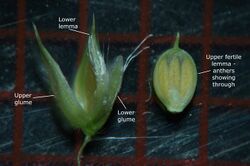Biology:Glume
From HandWiki
Short description: One of two bracts enclosing a flower spikelet in grasses

Upper and lower glumes of Urochloa mosambicensis, a grass
In botany, a glume is a bract (leaf-like structure) below a spikelet in the inflorescence (flower cluster) of grasses (Poaceae) or the flowers of sedges (Cyperaceae). There are two other types of bracts in the spikelets of grasses: the lemma and palea.
In grasses, two bracts known as "glumes" form the lowermost organs of a spikelet (there are usually two but one is sometimes reduced; or rarely, both are absent).[1] Glumes may be similar in form to the lemmas, the bracts at the base of each floret.
In sedges, by contrast, a glume is a scale at the base of each flower in a spikelet.[2]
References
- ↑ Stace, C. A. (2010). New Flora of the British Isles (3 ed.). Cambridge, U.K.: Cambridge University Press. pp. 974–77. ISBN 9780521707725.
- ↑ Jermy, AC; Simpson, DA; Foley, MJY; Porter, MS (2007). Sedges of the British Isles. Botanical Society of Britain and Ireland. p. 521. ISBN 9780901158352.
 |

